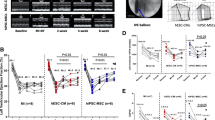Abstract
We aim to study the amelioration effect of adenovirus5-mediated human hepatocyte growth factor gene transfer on postinfarction heart failure in swine model. Twelve Suzhong young swine were randomly divided into 2 groups of 6 pigs each: Ad5-HGF group and mock-vector Ad5 group. Four weeks after ligation of the left anterior descending coronary artery, Ad5-HGF was intracoronarily transferred into the myocardium. Simultaneously, gate cardiac perfusion imaging was performed to evaluate the heart function. Three weeks later, gate cardiac perfusion imaging was performed again, then the hearts were removed and sectioned for immunohistochemical examination to illustrate the effects of Ad5-HGF on infarcted myocardium. The expression of HGF was examined by ELISA. The results were: (1) compared with the mock-vector Ad5 group, high expression of human HGF was observed in the myocardium of Ad5-HGF group; (2) in the Ad5-HGF group, the number of CD117+ cells co-expressing c-Met per mm2 was significantly larger; (3) the improvement in LVEF was greater in the Ad5-HGF group than in the mock-vector Ad5 group. We concluded that: (1) high expression of human HGF was observed in the myocardium through intracoronary gene transfection; (2) HGF can improve the mobilization of CD117+/c-Met+ stem cells into ischemic myocardium. The amelioration effect of HGF on postinfarction heart failure could not be limited to stimulating angiogenesis, anti-apoptosis, anti-fibrosis, but was also involved in the recruitment of stem cells into myocardium.
Similar content being viewed by others
References
Vasant J, Y Joseph W, Pirolli T J, et al. Induction of angiogenesis and inhibition of apoptosis by hepatocyte growth factor effectively treats postischemic heart failure. J Card Surg, 2005, 20: 93–101, 10.1111/j.0886-0440.2005.200373.x
Azuma J, Taniyama Y, Takeya Y, et al. Angiogenic and antifibrotic actions of hepatocyte growth factor improve cardiac dysfunction in porcine ischemic cardiomyopathy. Gene Ther, 2006, 20, Epub ahead of print
Li Y, Takemura G, Kosai K I, et al. Postinfarction treatment with an adenoviral vector expressing hepatocyte growth factor relieves chronic left ventricular remodeling and dysfunction in mice. Circulation, 2003, 107: 2499–2506, 12695295, 10.1161/01.CIR.0000065579.19126.B8, 1:CAS:528:DC%2BD3sXjs1antLo%3D
Ahmet I, Sawa Y, Yamaguchi T. Gene transfer of hepatocyte growth factor improves angiogenesis and function of chronic ischemic myocardium in canine heart. Ann Thorac Surg, 2003, 75: 1283–1287, 12683576, 10.1016/S0003-4975(02)04677-5
Kucia M, Dawn B, Hunt G, et al. Cells expressing early cardiac markers reside in the bone marrow and are mobilized into the peripheral blood after myocardial infarction. Circ Res, 2004, 95: 1191–1199, 15550692, 10.1161/01.RES.0000150856.47324.5b, 1:CAS:528:DC%2BD2cXhtVensrjJ
Fang T L, Min J, Deng X G, et al. Bone marrow mesenchymal stem cells are induced to differentiate into cardiomyocytes by hepatocyte growth factor in vitro. Chin J Pathophysiol, 2004, 20: 1167–1170
Forte G, Minieri M, Cossa P, et al. Hepatocyte growth factor effects on mesenchymal stem cells: proliferation, migration and differentiation. Stem Cells, 2006, 24: 23–33, 16100005, 10.1634/stemcells.2004-0176, 1:CAS:528:DC%2BD28XhtFKiur%2FI
Duan H F, Wu C T, Wu D L, et al. Treatment of myocardial ischemia with bone marrow-derived mesenchymal stem cells overexpressing hepatocyte growth factor. Mol Ther, 2003, 8: 467–474, 12946320, 10.1016/S1525-0016(03)00186-2, 1:CAS:528:DC%2BD3sXms1yisrs%3D
Comoglio P. Structure, biosynthesis and biochemical properties of the HGF receptor in normal and malignant cells. In: Goldberg I D, Rosen E M, eds. Hepatocyte Growth Factor-Scatter Factor (HGFSF) and the c-Met Receptor. Basel: Birkauser-Verlag, 1993. 131–165
Matssumoto K, Nakamura T. Hepatocyte growth factor (HGF) as a tissue organizer for organogenesis and regeneration. Biochem Biophys Res Commun, 1997, 239: 639–644, 10.1006/bbrc.1997.7517
Boros P, Miller C M. Hepatocyte growth factor: a multifunctional cytokine. Lancet, 1995, 345: 293–295, 7837864, 10.1016/S0140-6736(95)90279-1, 1:STN:280:ByqC3sbmvVE%3D
Matsumoto K, Nakamura T. Hepatocyte growth factor: Renotropic role and potential therapeutics for renal diseases. Kidney Int, 2001, 59: 2023–2038, 11380804, 1:CAS:528:DC%2BD3MXks1KltLw%3D
Yamaura K, Ito K, Tsukioka K, et al. Suppression of acute and chronic rejection by hepatocyte growth factor in a murine model of cardiac transplantation: Induction of tolerance and prevention of cardiac allograft vasculopathy. Circulation, 2004, 110: 1650–1657, 15364799, 10.1161/01.CIR.0000143052.45956.71, 1:CAS:528:DC%2BD2cXnsVKqu78%3D
Shirakawa Y, Sawa Y, Takewa Y, et al. Gene transfection with human hepatocyte growth factor complementary DNA plasmids attenuates cardiac remodeling after acute myocardial infarction in goat hearts implanted with ventricular assist devices. J Thorac Cardiovasc Surg, 2005,130: 624–632, 16153905, 10.1016/j.jtcvs.2004.02.045, 1:CAS:528:DC%2BD2MXhtFWmur7K
Wang W, Yang Z J, Ma D C, et al. Induction of collateral artery growth and improvement of postinfarct heart function by hepatocyte growth factor gene transfer. Acta Pharmacol Sin, 2006, 27: 555–560, 16626510, 10.1111/j.1745-7254.2006.00306.x, 1:CAS:528:DC%2BD28XkslCjur4%3D
Kocher A A, Schuster M D, Szabolcs M J, et al. Neovascularization of ischemic myocardium by human bone-marrow-derived angioblasts prevents cardiomyocyte apoptosis, reduces remodeling and improves cardiac function. Nat Med, 2001, 7: 430–436, 11283669, 10.1038/86498, 1:CAS:528:DC%2BD3MXis1yls7s%3D
Orlic D, Kajstura J, Chimenti S, et al. Bone marrow cells regenerate infracted myocardium. Nature, 2001, 410: 701–705, 11287958, 10.1038/35070587, 1:CAS:528:DC%2BD3MXivFSmsb4%3D
Neuss S, Becher E, Woltje M, et al. Functional expression of HGF and HGF receptor/c-met in adult human mesenchymal stem cells suggests a role in cell mobilization, tissue repair, and wound healing. Stem Cells, 2004, 22: 405–414, 15153617, 10.1634/stemcells.22-3-405, 1:CAS:528:DC%2BD2cXlsFCnsrw%3D
Beltrami A P, Barlucchi L, Torella D, et al. Adult cardiac stem cells are multipotent and support myocardial regeneration. Cell, 2003, 114: 63–776, 10.1016/S0092-8674(03)00687-1
Author information
Authors and Affiliations
Corresponding author
Additional information
Supported by the Medical Key Member of “Medicine Renaissance Projects of Jiangsu Province” to Yang Z J and the Chinese National High Technology Development Program (863 Program) (Grant No. 2004CB518801)
Rights and permissions
About this article
Cite this article
Yang, Z., Wang, W., Ma, D. et al. Recruitment of stem cells by hepatocyte growth factor via intracoronary gene transfection in the postinfarction heart failure. SCI CHINA SER C 50, 748–752 (2007). https://doi.org/10.1007/s11427-007-0102-5
Received:
Accepted:
Published:
Issue Date:
DOI: https://doi.org/10.1007/s11427-007-0102-5




